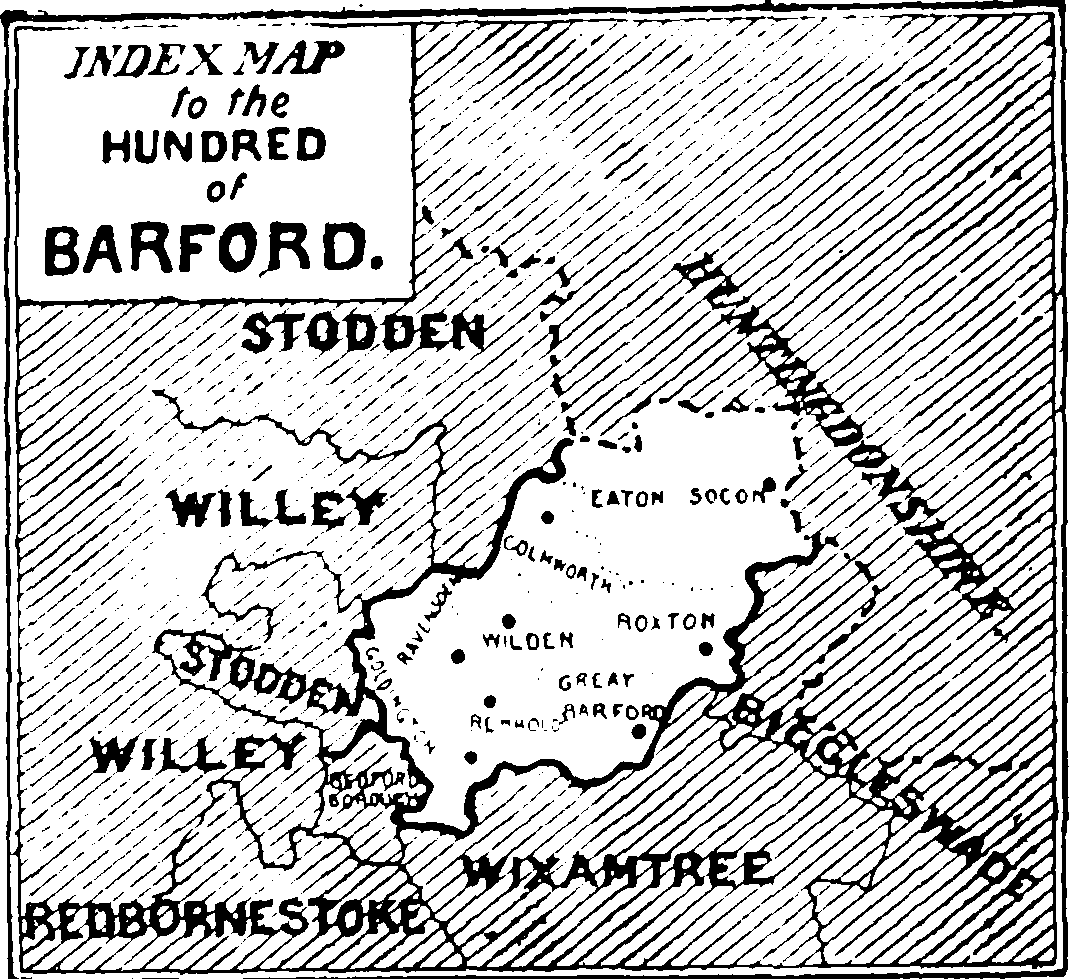A History of the County of Bedford: Volume 3. Originally published by Victoria County History, London, 1912.
This free content was digitised by double rekeying. All rights reserved.
'The hundred of Barford: Introduction', in A History of the County of Bedford: Volume 3, ed. William Page (London, 1912), British History Online https://prod.british-history.ac.uk/vch/beds/vol3/p180 [accessed 31 January 2025].
'The hundred of Barford: Introduction', in A History of the County of Bedford: Volume 3. Edited by William Page (London, 1912), British History Online, accessed January 31, 2025, https://prod.british-history.ac.uk/vch/beds/vol3/p180.
"The hundred of Barford: Introduction". A History of the County of Bedford: Volume 3. Ed. William Page (London, 1912), British History Online. Web. 31 January 2025. https://prod.british-history.ac.uk/vch/beds/vol3/p180.
The hundred of Barford
CONTAINING THE PARISHES OF
| GREAT BARFORD | RAVENSDEN | ||
| COLMWORTH | RENHOLD | ||
| EATON SOCON (WITH ITS HAMLETS) | ROXTON | ||
| GOLDINGTON | WILDEN (fn. 1) | ||
The boundaries of this hundred have not altered since Domesday, when the following places, amounting to about 114 hides, were assessed: Great Barford, Colmworth with Channels End, Eaton with Wyboston and Sudbury, Goldington with Putnoe, Salph End (in Ronhale), Roxton with Chawston and Wilden. Ravensden is not mentioned in the Survey at all. (fn. 2) The hundred included the feudal barony and soke of Eaton and the religious houses of Bushmead and Newnham.
Barford has always been a royal hundred, though farmed out at various times; in the 13th century its rent ranged from 1 to 4 marks. (fn. 3) In the Feudal Aid of 1302 knight service was owed for eighteen fees in this hundred, and in 1346 nearly fifteen fees were assessed at £29 8s. 8d. (fn. 4) On the occasion of a general muster in 1539 Barford provided 44 archers, 130 billmen and 20 pairs of harness. (fn. 5) The sum of £17 2s. 10d. was raised for a subsidy in 1537 (fn. 6); nearly fifty years later on a similar occasion Barford was assessed at £57 17s. 7½d., but only raised £7 15s. 9½d. (fn. 7) In 1629 Charles I made a grant of the hundred to Gilbert North at a yearly rent of £12 4s. 8½d. to be held as of the manor of East Greenwich in free and common socage. (fn. 8) The ship-money levied on the county in 1638 produced £4 13s. from Barford. (fn. 9) A survey of the hundred made during the Commonwealth states that at that time the hundred had passed to Oliver Earl of Bolingbroke, who held it in common with Stodden Hundred. (fn. 10) Like that hundred it is declared by Lysons to have been the possession of Lord St. John (the descendant of the Earl of Bolingbroke) at the beginning of the 19th century. (fn. 11)

INDEX MAP to the HUNDRED of BARFORD.
In the census return made on this hundred in 1831 its area was said to be 26,170 acres, and its population, mainly, then as now, agricultural, 5,880. (fn. 12)
